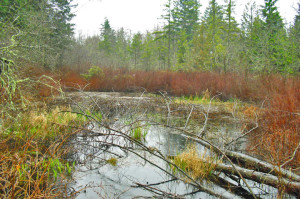Wetland and Stream Permitting Process 101
The state’s Growth Management Act requires that local governments enact critical area ordinances: wetlands, streams and lakes are all ‘critical areas’. If the permitting agency has reason to believe that you may have critical areas on your property, they would request that you hire an Environmental Consulting Service – like Red Wing – to assess and map the critical areas. Upon receiving a report or letter from the consultant, the agency may visit the site to verify the consultant’s conclusions. The agency will then provide a verification letter that you can submit with your building permit application or with your septic application.
Whether merely verifying if a critical area is present or requiring a report with a delineation depends on how big the buffers are and where the critical area is – in relation to the proposed project. Wetland delineation is the process of finding the wetland’s edge and rating is the process of figuring out how unique a wetland is or the level of functions that it provides society. Regulated wetlands have wetland buffers or areas that extend from their edges in which many activities are not allowed. The wetland’s rating determines its buffer width. Methodology for delineation and rating has been developed by the US Army Corps of Engineers and the Washington Department of Ecology.
Streams, lakes, ponds and coastal shorelines also have buffers with varying widths. Factors such as size, whether or not it flows all year and fish presence determine the width of stream buffers. The permitting agency will require that the aquatic area’s ordinary high water mark (OHWM) be determined. This is a service that Red Wing Environmental Consulting Service provides.
If critical areas or their buffers cover much of your parcel, it is still possible to build a house on the parcel. Most jurisdictions allow buffer averaging in which the buffer is expanded in some areas and reduced in others so that the overall buffer area stays the same and a house can be built. If your undeveloped parcel is located in an unincorporated area and qualifies for a septic system, many counties will allow you to build, even if critical area buffers cover your property. In King County, this process is known as a critical areas alteration exception or a reasonable use exception.
If you want to clear the vegetation on a wetland or fill it, the process becomes more expensive and drawn out. Section 404 of the federal Clean Water Act requires ‘no net losses’ of wetland functions and area. Section 404 permits generally require mitigation in the form of creating new wetlands and enhancement. Approving this can take a year and will involve more consultation. In addition, such plans would involve permits from the Washington Department of Fish and Wildlife and the Department of Ecology. Generally, property owners do not bother with Section 404 permits if all they want to do is build a single home.

